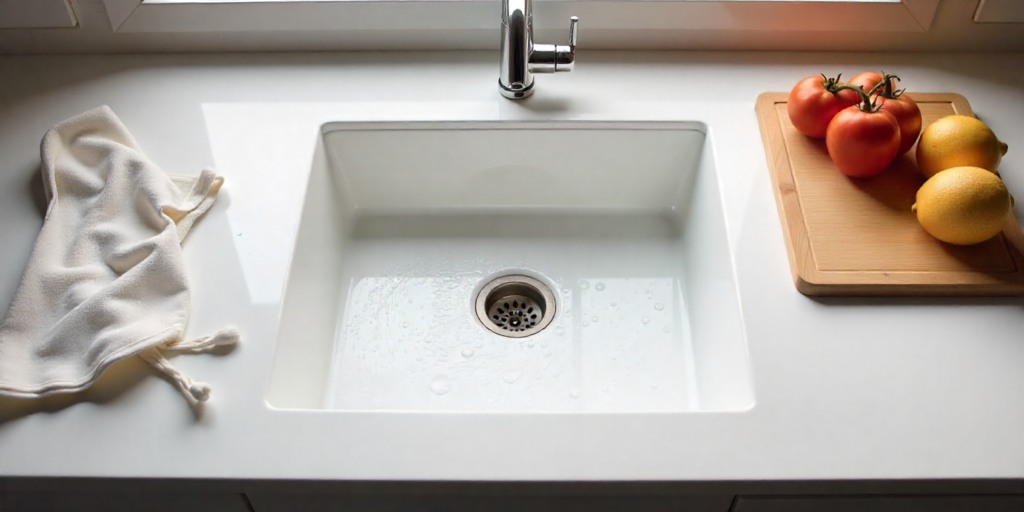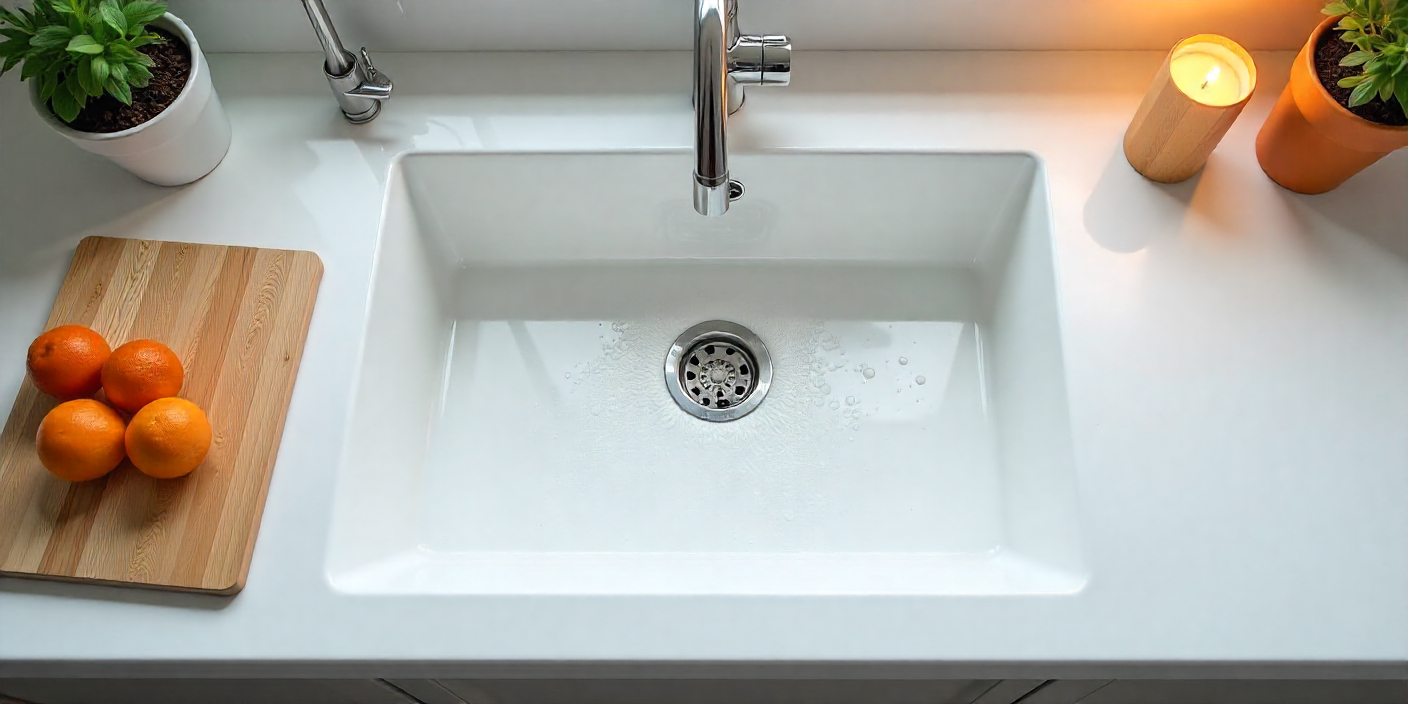You know that feeling? You wipe down your kitchen counter for the hundredth time that day, and your sponge still catches on that annoying lip where the sink meets the countertop. Grime magnet. Water trap. Design flaw. It’s a universal kitchen gripe, right? Well, what if I told you there’s a solution that’s been hiding in plain sight for decades in high-end design, finally becoming accessible? Enter sinkom.
Forget the clunky, separate sink-and-countertop dance. Sinkom – shorthand for the seamless integration of sink and countertop into a single, unified piece – is more than just a trend; it’s a fundamental shift towards smarter, sleeker, and significantly easier-to-maintain surfaces. Think of it as the countertop absorbing the sink. No seams. No edges. Just pure, flowing surface. Intrigued? You should be. Let’s dive into why sinkom might just be the upgrade your kitchen or bathroom desperately needs.
Here’s what we’ll cover:
- Sinkom 101: What Exactly Is It? (Beyond the Buzzword)
- Why Bother? The Undeniable Perks of Going Seamless
- Material World: What’s Your Sinkom Made Of? (Pros & Cons)
- The Installation Lowdown: What to Expect
- Sinkom vs. Traditional Sinks: The Clear Winner?
- Is Sinkom Right For YOU? (Honest Considerations)
- Sinkom in Action: Beyond the Kitchen Sink
- FAQs: Your Burning Sinkom Questions, Answered
- The Future of Surfaces: Where Sinkom is Headed
Sinkom 101: What Exactly Is It? (Beyond the Buzzword)
Okay, let’s strip away the jargon. At its core, sinkom simply means your sink basin and your countertop are crafted from the same slab of material and fused together seamlessly during fabrication. There is no physical joint, ridge, or gap between the basin and the surrounding counter. It’s all one continuous surface flowing into the basin.
Think of it like a river carving its path through stone – the basin is a depression formed within the countertop material itself, or a separate sink is so perfectly bonded and finished that the seam becomes utterly invisible. The result? A surface that looks sculpted, not assembled. It’s the ultimate expression of minimalist, modern design.
Why Bother? The Undeniable Perks of Going Seamless
Why are designers and homeowners increasingly demanding sinkom? It’s not just about looking fancy (though it certainly does). The benefits are genuinely practical and transformative:
- Hygiene Hero: This is the big one. No seam = no grime trap. That notorious ridge where traditional sinks meet the counter? It’s a breeding ground for bacteria, mold, and gunk. With sinkom, wiping crumbs or spills directly into the sink becomes effortless. Cleaning is dramatically simplified – just wipe the entire surface straight through. Honestly, this hygiene advantage isn’t talked about enough!
- Aesthetics That Wow: Let’s be real, it looks incredible. The clean lines, the uninterrupted flow, the sheer minimalism – sinkom elevates the entire space. It creates a sense of expansiveness and sophistication that a drop-in or undermount sink simply can’t match. Your countertop becomes a true focal point, not just a backdrop.
- Durability Done Right: When done properly with quality materials and installation, the bonded joint in a sinkom setup (if applicable) is incredibly strong. There’s no metal rim to chip or separate over time. The monolithic look translates to monolithic strength in many cases.
- Effortless Maintenance: Spills pool? Just push them right into the basin. Cleaning involves one smooth motion across the entire counter and sink. No more fiddling with caulk lines or scrubbing that annoying ridge. It’s a game-changer for busy households.
- Increased Usable Space: Without a raised sink rim eating into your counter real estate, you gain precious usable space right at the sink’s edge. Perfect for stacking dishes pre-wash or prepping ingredients.
Material World: What’s Your Sinkom Made Of? (Pros & Cons)
Not all materials play nicely with the sinkom concept. Here’s a breakdown of the most common players:
| Material | Pros | Cons | Best For |
| Solid Surface (Corian, Hi-Macs, etc.) | Seamless integration is its forte! Easy to repair scratches, vast color choices, non-porous, warm feel. | Can scratch/scorch more easily than stone, may show wear over time in high-traffic areas. | Kitchens (especially busy families), bathrooms, commercial spaces. |
| Engineered Quartz (Silestone, Caesarstone, etc.) | Extremely durable, scratch/stain/heat resistant, non-porous, consistent color/pattern. Very popular. | True seamless basin requires specialized fabrication. Visible seams possible if bonding sink piece. Heavy. | Kitchens demanding high durability and style. |
| Natural Stone (Granite, Marble) | Unmatched natural beauty, unique patterns, high heat resistance. | Porous (requires sealing), can stain/etch (especially marble), brittle edges prone to chipping, true seamless fabrication is complex/expensive. | Luxury kitchens/bathrooms where aesthetics are paramount (accept maintenance). |
| Porcelain Slabs | Incredibly scratch/stain resistant, non-porous, bold colors/patterns possible. | Brittle, true seamless fabrication is rare/highly specialized, edges vulnerable. | Primarily countertops with undermount sinks achieving a near-sinkom look. |
| Stainless Steel (Integrated) | Super hygienic, durable, heat resistant, modern industrial look. | Shows scratches/swirls (“brushing”), can be noisy, can dent, limited design styles. | Professional kitchens, modern homes, wet bars. |
My Take? For most homeowners seeking the true sinkom experience – that perfect, unbroken flow – solid surface remains the gold standard. Quartz is a phenomenal performer overall but achieving the absolute seamless look can be trickier and depends heavily on fabricator skill. Stone is gorgeous but demands commitment to upkeep.
Read also: Lillienu: The Future of Sustainable Living
The Installation Lowdown: What to Expect
Here’s where things get crucial. Sinkom is NOT a DIY project. Seriously, don’t even think about it. This is precision work for highly skilled fabricators and installers.
- Template & Measure: Laser precision is key. Your countertop space and sink cabinet are meticulously measured.
- Fabrication Magic: This happens off-site in a specialized workshop. For solid surface and quartz, the sink basin is either thermoformed from the slab (solid surface) or the sink piece is cut and will be bonded seamlessly. Stone requires incredible craftsmanship to carve the basin.
- The Bonding Process (if applicable): For quartz or stone sinkoms involving bonding, this is the critical step. High-strength adhesives and specialized clamps are used. The joint is then meticulously sanded and polished to complete invisibility. This is the step that separates the masters from the amateurs.
- Installation: The monolithic or perfectly bonded piece is carefully transported and installed. Seamless integration with walls or other counters requires expert fitting.
Pro Tip: Choosing your fabricator is everything. Look for extensive, proven experience specifically with seamless sinkom installations. Ask to see examples of their work – pay close attention to the sink-to-counter transition. A poorly executed bond will haunt you.
Sinkom vs. Traditional Sinks: The Clear Winner?
Let’s break it down plainly:
- Undermount Sinks: Offer a clean look above the counter, but that seam underneath is still there, collecting grime and water. Requires periodic caulking. Sinkom eliminates this entirely.
- Drop-In (Top-mount) Sinks: The rim sits on the counter. That rim is the ultimate dirt trap and visually breaks up the surface. Sinkom wins hands-down on hygiene and aesthetics.
- Farmhouse Sinks (Apron Front): Offer a charming aesthetic, but the front face is exposed and the top rim still interfaces with the counter (often with a seam). Different look, different pros/cons, not directly comparable on seamless integration.
The Verdict: For pure hygiene, ease of cleaning, minimalist aesthetics, and seamless flow, sinkom is objectively superior to traditional sink installations. The catch? Cost and the reliance on expert installation.
Is Sinkom Right For YOU? (Honest Considerations)
Before you jump on the seamless bandwagon, let’s get real:
- Budget: Sinkom is typically more expensive than a standard countertop + undermount sink combo. You’re paying for specialized materials and high-end fabrication. Is that premium worth the benefits to you?
- Fabricator Availability: Finding truly skilled sinkom fabricators outside major metro areas can be challenging. Don’t compromise on skill.
- Material Choice: Your desired material must be suitable for sinkom fabrication (see the table above!). Love the look of a specific porous stone? Understand the maintenance commitment.
- Lifestyle: If you’re a meticulous cleaner who hates grime traps, sinkom is a dream. If you regularly hack apart pumpkins or use heavy cast iron pans recklessly, consider potential durability concerns depending on the material.
- The “Uh-Oh” Factor: What if you damage the sink basin? Repairing a chip or deep scratch in a true integrated sinkom basin is significantly harder (sometimes impossible without replacing the whole section) than swapping out a traditional stainless steel undermount sink. Solid surface is easiest to repair in-situ.
In my experience, people who prioritize a hyper-clean, minimalist aesthetic and low daily maintenance absolutely fall in love with sinkom and never look back. It solves a genuine, everyday annoyance.
Sinkom in Action: Beyond the Kitchen Sink

While kitchens are the prime battleground for grime, the sinkom revolution isn’t stopping there:
- Bathroom Vanities: Imagine a stunning, flowing surface from wall to wall, with the sink basin emerging seamlessly. No more nasty caulk lines! Especially beautiful in modern or minimalist bathrooms. Solid surface and quartz are popular choices here.
- Wet Bars & Butler’s Pantries: Create a sleek, ultra-functional prep and clean-up area. The hygiene and easy wipe-down are perfect for these spaces.
- Laundry Rooms: Utility meets style. A seamless sinkom in a laundry sink makes cleaning up after messy chores a breeze.
- Commercial Applications: Restaurants, labs, salons – anywhere hygiene is paramount, sinkom is becoming a gold standard.
The principle remains the same: eliminate seams, enhance hygiene, boost aesthetics, simplify life.
FAQs:
- Q: Is sinkom just an undermount sink?
A: No! While undermount sinks offer a cleaner look than drop-ins, they still have a seam (albeit underneath) between the sink rim and the countertop. Sinkom eliminates that seam entirely, creating a truly continuous surface. - Q: Are sinkom countertops hard to clean?
A: Absolutely not! This is their biggest strength. With no ridge or seam to trap dirt and water, cleaning is incredibly easy. Just wipe spills and crumbs straight across the counter and into the sink basin. No scrubbing grimy edges. - Q: Can I replace just the sink part later?
A: Generally, no. In a true integrated sinkom (especially solid surface thermoformed or stone carved), the sink basin is part of the monolithic countertop. If bonded (like some quartz), replacing the sink piece would be complex and likely require replacing that section of the counter. It’s designed as a single unit. - Q: Is sinkom more expensive?
A: Yes, typically. The specialized fabrication required (especially for a seamless finish) and often the need for a single, larger slab of material increase the cost compared to a standard countertop + separate sink installation. Expect a premium. - Q: Do sinkom countertops chip easily?
A: It depends heavily on the material. Engineered quartz is very chip-resistant. Solid surface is softer but can be repaired. Natural stone (like granite edges or marble) can be more prone to chipping, especially on thin edges around the basin. Using cutting boards and avoiding dropping heavy objects is always wise. - Q: Can I have a garbage disposal with a sinkom?
A: Yes! There’s no inherent issue with installing a garbage disposal under a sinkom sink basin. The plumbing considerations are the same as for any undermount sink. Ensure your cabinet space accommodates it. - Q: How long does a sinkom installation take?
A: The fabrication process takes longer than standard countertops due to the complexity. After templating, allow 1-3 weeks for fabrication depending on the shop’s workload and material. Installation day itself is similar to other countertops.
The Future of Surfaces: Where Sinkom is Headed
Sinkom feels less like a fleeting trend and more like the logical evolution of surface design. As fabrication technology advances (especially for trickier materials like quartz and porcelain), seamless integration will become more accessible and affordable. We’ll likely see even more innovative applications – think integrated drainboards, seamless backsplash transitions, or combined sinkom/workstation areas.
The desire for hygienic, easy-to-maintain, and beautiful spaces is universal. Sinkom delivers on all three. It solves a problem we didn’t always articulate but universally felt: the annoyance of that darn sink seam.
So, is it time to ditch the ridge? If you’re planning a kitchen or bathroom remodel, investing in surfaces that last, or simply crave that effortless clean and minimalist flow, sinkom deserves serious consideration. It’s more than a sink; it’s a smarter way to live with your surfaces. What’s the one thing you hate most about your current sink setup? Maybe sinkom is the answer you’ve been searching for.
You may also like: Penthousehub: The Secret Gateway to Luxury Living

